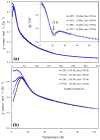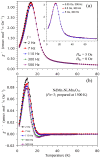B-Site-Ordered and Disordered Structures in A-Site-Ordered Quadruple Perovskites RMn3Ni2Mn2O12 with R = Nd, Sm, Gd, and Dy
- PMID: 39683648
- PMCID: PMC11644023
- DOI: 10.3390/molecules29235488
B-Site-Ordered and Disordered Structures in A-Site-Ordered Quadruple Perovskites RMn3Ni2Mn2O12 with R = Nd, Sm, Gd, and Dy
Abstract
ABO3 perovskite materials with small cations at the A site, especially with ordered cation arrangements, have attracted a lot of interest because they show unusual physical properties and deviations from general perovskite tendencies. In this work, A-site-ordered quadruple perovskites, RMn3Ni2Mn2O12 with R = Nd, Sm, Gd, and Dy, were synthesized by a high-pressure, high-temperature method at about 6 GPa. Annealing at about 1500 K produced samples with additional (partial) B-site ordering of Ni2+ and Mn4+ cations, crystallizing in space group Pn-3. Annealing at about 1700 K produced samples with disordering of Ni2+ and Mn4+ cations, crystallizing in space group Im-3. However, magnetic properties were nearly identical for the Pn-3 and Im-3 modifications in comparison with ferromagnetic double perovskites R2NiMnO6, where the degree of Ni2+ and Mn4+ ordering has significant effects on magnetic properties. In RMn3Ni2Mn2O12, one magnetic transition was found at 26 K (for R = Nd), 23 K (for R = Sm), and 22 K (for R = Gd), and two transitions were found at 10 K and 36 K for R = Dy. Curie-Weiss temperatures were close to zero in all compounds, suggesting that antiferromagnetic and ferromagnetic interactions are of the same magnitude.
Keywords: A-site-ordered quadruple perovskites; B-site double ordering; crystal structures; structural disorder.
Conflict of interest statement
The authors declare no conflicts of interest.
Figures












Similar articles
-
A Site-Ordered Quadruple Perovskites, RMn3Ni2Mn2O12 with R = Bi, Ce, and Ho, with Different Degrees of B Site Ordering.Molecules. 2025 Apr 14;30(8):1749. doi: 10.3390/molecules30081749. Molecules. 2025. PMID: 40333720 Free PMC article.
-
High-Pressure Synthesis, Crystal Structures, and Properties of A-Site Columnar-Ordered Quadruple Perovskites NaRMn2Ti4O12 with R = Sm, Eu, Gd, Dy, Ho, Y.Inorg Chem. 2020 Jul 6;59(13):9065-9076. doi: 10.1021/acs.inorgchem.0c00938. Epub 2020 Jun 9. Inorg Chem. 2020. PMID: 32515189
-
Five-Fold Ordering in High-Pressure Perovskites RMn3O6 (R = Gd-Tm and Y).Inorg Chem. 2017 May 1;56(9):5210-5218. doi: 10.1021/acs.inorgchem.7b00347. Epub 2017 Apr 20. Inorg Chem. 2017. PMID: 28425715
-
Double Double Cation Order in the High-Pressure Perovskites MnRMnSbO6.Angew Chem Int Ed Engl. 2016 Aug 1;55(32):9340-4. doi: 10.1002/anie.201603526. Epub 2016 Jun 17. Angew Chem Int Ed Engl. 2016. PMID: 27312417
-
Ferrimagnetic Ordering and Spin-Glass State in Diluted GdFeO3-Type Perovskites (Lu0.5Mn0.5)(Mn1-xTix)O3 with x = 0.25, 0.50, and 0.75.Materials (Basel). 2023 Feb 10;16(4):1506. doi: 10.3390/ma16041506. Materials (Basel). 2023. PMID: 36837134 Free PMC article.
Cited by
-
A Site-Ordered Quadruple Perovskites, RMn3Ni2Mn2O12 with R = Bi, Ce, and Ho, with Different Degrees of B Site Ordering.Molecules. 2025 Apr 14;30(8):1749. doi: 10.3390/molecules30081749. Molecules. 2025. PMID: 40333720 Free PMC article.
-
Above-room-temperature strain-stable half-metallic phase owing to a high thermoelectric response in CaCu3Cr2Re2O12.RSC Adv. 2025 Jun 17;15(26):20397-20406. doi: 10.1039/d5ra02609a. eCollection 2025 Jun 16. RSC Adv. 2025. PMID: 40530312 Free PMC article.
References
-
- Vasala S., Karppinen M. A2B′B′′O6 perovskites: A review. Prog. Solid State Chem. 2015;43:1–36. doi: 10.1016/j.progsolidstchem.2014.08.001. - DOI
-
- Vasil’ev A.N., Volkova O.S. New functional materials AC3B4O12 (Review) Low Temp. Phys. 2007;33:895–914. doi: 10.1063/1.2747047. - DOI
-
- Long Y. A-site ordered quadruple perovskite oxides AA′3B4O12. Chin. Phys. B. 2016;25:078108. doi: 10.1088/1674-1056/25/7/078108. - DOI
Grants and funding
LinkOut - more resources
Full Text Sources

